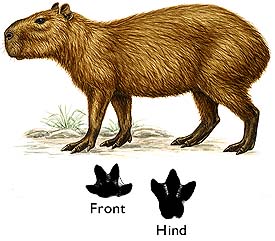Paca
PacaAgouti paca Makushi name: Urana Creole name: Labba Size: body=70 cm; weight=8 kg Description: Large bodied and stocky; reddish-brown with four obvious lines or stripes of white spots from shoulder to rump on each side, and a very short, inconspicuous tail. This is the second-largest rodent in Iwokrama. Bright red eyeshine. Activity: Terrestrial, nocturnal, it is often active late in the evening (midnight or later), especially in areas where it is frequently hunted (it is prized for its tasty flesh). Habits: Solitary or sometimes in male-female pairs. Usually silent. Often seen as it forages for fruit on the forest floor and especially along creeks, streams, and rivers. Habitat: Forest, secondary brush. Signs: Relatively broad tracks (40 mm wide or more in adults) with four toes showing on the front track and three on the hind. Status: Often common. Distribution in Iwokrama


